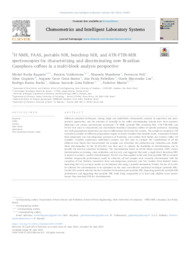H NMR, FAAS, portable NIR, benchtop NIR, and ATR-FTIR-MIR spectroscopies for characterizing and discriminating new Brazilian Canephora coffees in a multi-block analysis perspective.
H NMR, FAAS, portable NIR, benchtop NIR, and ATR-FTIR-MIR spectroscopies for characterizing and discriminating new Brazilian Canephora coffees in a multi-block analysis perspective.
Author(s): BAQUETA, M. R.; VALDERRAMA, P.; MANDRONE, M.; POLI, F.; COQUEIRO, A.; COSTA-SANTOS, A. C.; REBELLATO. A. A.; LUZ, G. M.; ROCHA, R. B.; PALLONE, J. A. L.; MARINI, F.
Summary: Different analytical techniques, mixing single and multi-block chemometric analyses in supervised and unsu- pervised approaches, and the selection of variables in the coffee discrimination domain have been reported. Molecular and atomic spectroscopic techniques (1H NMR, portable NIR, benchtop NIR, ATR-FTIR-MIR, and FAAS) were used to characterize and discriminate Brazilian Canephora coffees of specific producers, including two with geographical indication, and also to differentiate them from the Arabica. The sample set comprised 100 Canephora samples of different geographical origins in Brazil (Conilon from Espírito Santo, Amazonian Robusta from indigenous and non-indigenous producers of Rondonia, and Conilon from Bahia) and Arabica coffee (25 samples). ComDim exploratory multi-block analysis was first used to evaluate the contributions of all the different data blocks that characterized the samples and determine the calibration and validation sets. Multi- block discrimination by the SO-PLS-LDA was then used to validate the feasibility of discrimination, and to identify the relevant analytical techniques. The discrimination based on all the blocks presented 100% correct discrimination on training, cross-validation, and test sets, and suggested that only a single block (benchtop NIR) is needed to achieve a perfect discrimination. PLS-DA was then applied to the data from portable NIR to evaluate whether comparable performances could be achieved; all test samples were correctly discriminated with the exception of two Robusta Amazonico from non-indigenous producers and two Conilon from Espírito Santo, indicating that very accurate results can be obtained also using a portable instrument. Finally, the use of CovSel- DA allowed the discrimination to be optimized on the most cost-effective analytical technique (portable NIR). CovSel-LDA models selected the best variables for benchtop and portable NIR, impacting positively portable NIR performance and suggesting that portable NIR could bring comparable or at least only slightly worse perfor- mance than benchtop NIR for discrimination.
Publication year: 2023
Types of publication: Journal article
Unit: Embrapa Rondônia
Keywords: Coffee, Conilon, Data fusio, Fine Amazonian Robusta coffee, Multi-block
Observation
Some of Embrapa's publications are published as ePub files. To read them, use or download one of the following free software options to your computer or mobile device. Android: Google Play Books; IOS: iBooks; Windows and Linux: Calibre.
Access other publications
Access the Agricultural Research Database (BDPA) to consult Embrapa's full library collection and records.
Visit Embrapa Bookstore to purchase books and other publications sold by Embrapa.

